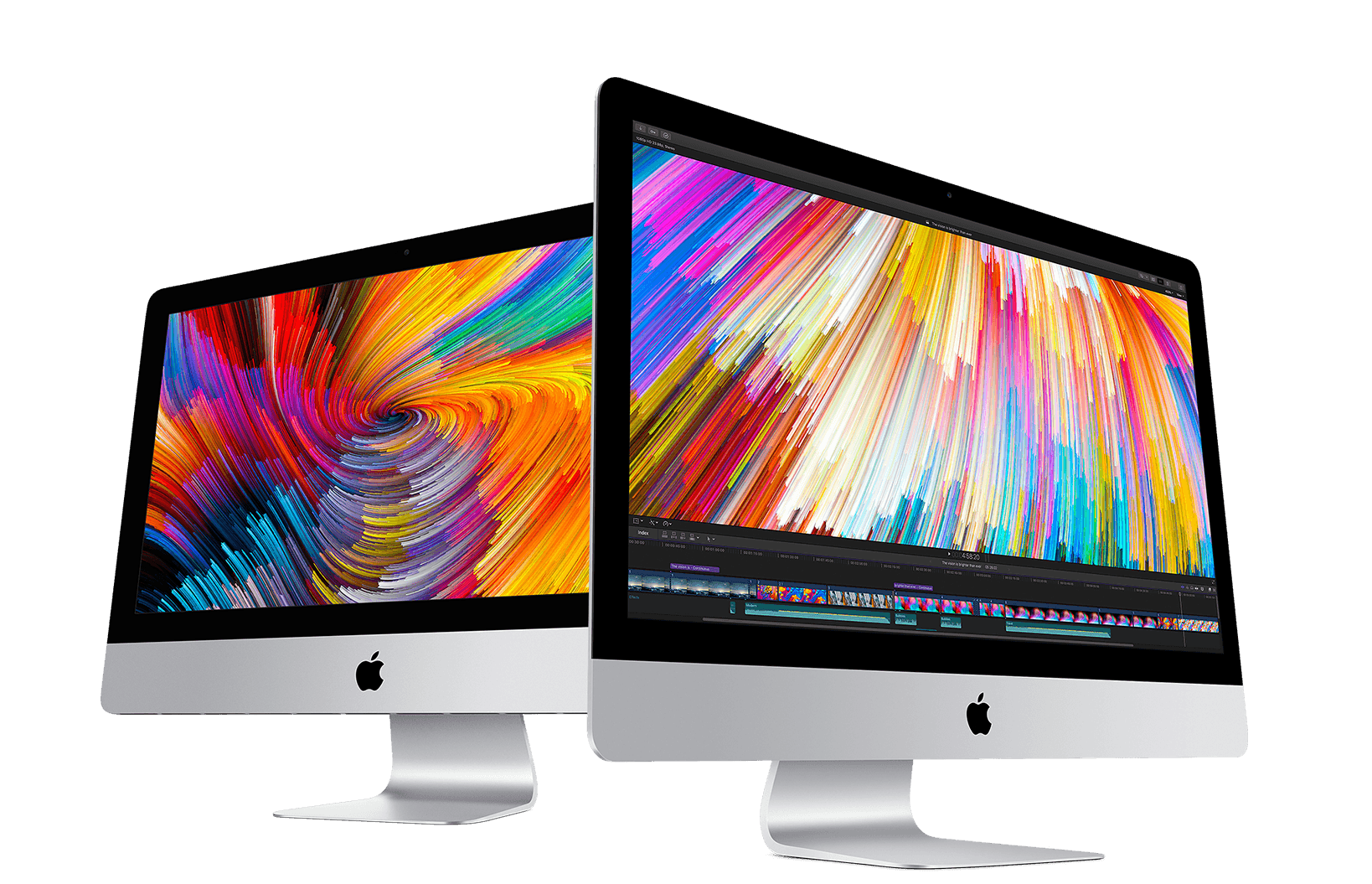Features
The screen itself is a pretty routine affair based on TN panel technoogy. It’s 22 inches in diagonal and offers a full-HD 1,920 x 1,080 pixel grids. Nothing special for a 22-inch PC monitor, but a hefty resolution by Android standards.
Viewsonics claims regarding panel performance are par for the TN course, albeit the more modern, capable examples of the breed. Contrast comes in at 1,000-to-1 while pixle response is rated at 5ms.
If there’s one area where the Viewsonic VSD220 falls short as a monitor, it’s connectivity. There’s just a single micro HDMI input. In practice, that’s fine for most PCs. You can use a DVI-to-HDMI converter to connect to any PC with a DVI port. But it doesn’t make for the most flexible monitor.
ОС
ViewSonic VSD220 работает на базе Android 4.0.4, а его техническая начинка достаточно скромна. А именно — 2-хъядерный процессор TI OMAP 4430 с тактовой частотой 1 ГГц, GPU PowerVR SGX540, оперативная память 1 Гб, внутренняя — 8 Гб (в свободном доступе пользователя лишь порядка 5 Гб) с опцией увеличения за счет micro-SD карты. В устройстве использована не урезанная, полноценная версия Android — т.е. пользователь имеет возможность синхронизировать монитор с Google-аккаунтом и получает доступ в Google Play и т.д.
Скромный по современным понятиям процессор в сочетании с высоким разрешением приводит к не очень плавной работе интерфейса. В частности, заметно притормаживают операции перехода интерфейса между экранами, возврата на home-экран и вызова меню приложений, а также прорисовки окон с большим числом элементов. Что касается производительности монитора в играх, то тут показатели далеко не самые плохие — без проблем на ViewSonic VSD220 запустились как Angry Birds, так и более «тяжелые» игрушки типа шутера Dead Trigger. Просмотр видео-контента разрешением FullHD привел опять к притормаживанию (использовался плеер MX Player) с применением программного декодера, но после переключения устройства на аппаратный декодер ситуация улучшилась — картинка менялась плавно без всяких зависаний. Однако при использовании нового медиацентра XBMC ViewSonic VSD220 опять выдал торможение даже во время переключения между разными окнами интерфейса.
Монитор оснащен оптическим сенсором, способным одновременно отслеживать не более 2-х касаний. К сожалению, при затесте даже 2 касания устройство отслеживает не всегда — к примеру, при изменении масштаба ViewSonic VSD220 работает без нареканий, но при вращении карты в Google Maps процесс становится слабо контролируемым (вращение карты может происходить в обратном направлении либо карта меняет масштаб и т.д.).
ViewSonic VSD220 Smart Display Android OS
There are three key ingredients to making an Android system work. You need the right interface to control the system with, the right version of Android installed and enough power to get it running properly.
The ViewSonic VSD220 Smart Display performs respectably on all fronts. With a two-point multi-touch optical touchscreen, you can perform the two-fingered gestures that have become a key part of any modern touch-operated system. The most obvious is the pinch-to-zoom gesture, used throughout Android.
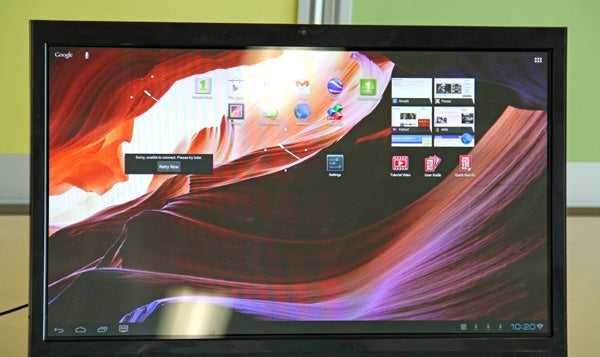
The version of Android used here is Ice Cream Sandwich 4.0, with just a few slight alterations. ViewSonic’s main change is the OSD overlay, giving input and screen controls. Other than that, Android here behaves just as it would in a 10-inch Android tablet.
Impressively, the Android UI doesn’t feel as if it has been unnaturally crammed into the ViewSonic VSD220 Smart Display, thanks to its core scalability. Unlike iOS, which tends to look odd when blown up to this size, Android Ice Cream Sandwich looks and feels relatively at home on a 21.5-inch screen.
However, there is the core issue that using the ViewSonic VSD220 Smart Display as you would a tablet feels quite laborious. There’s a lot of moving your hand from one side of the screen to another, and next to the small movements demanded by phones and tablets, the arm-waving required here feels like an awful lot of effort. And we’re not just saying that because we’re interminably lazy.
The screen is coated with toughened glass, but its surface is higher-friction than that of most tablets and smartphones, which doesn’t help either.
Escape from the Android UI by loading up an app and the situation often improves – a session of Angry Birds Star Wars on the ViewSonic VSD220 Smart Display is just as fun as you’d hope. Although the CPU used here is not powerful compared even to budget tablets like the Google Nexus 7, the dual-core 1GHz OMAP 4430 is powerful enough to make most popular Android games run at full speed.
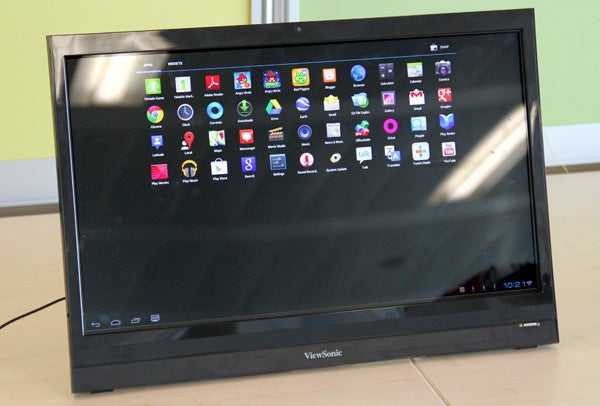
Many of the most graphically intensive games – first person shooters, for example – are not at all suited to being played on such a large touchscreen anyway.
There are jerky moments in day-to-day navigation of the Android interface, though, and they make us wish ViewSonic had equipped the Smart Display with Android 4.1 Jelly Bean, which significantly greased the cogs of the system.
What’s arguably more important is that ViewSonic has packed-in the majority of Google’s own apps. The Google Play app store is here, as are Gmail, Google Earth, Google Maps, Google Talk and others. The only significant omission from the Android staples is Google Navigation, which would be pretty useless in a GPS-less device anyway.
The inclusion of these services is a sign that this is a good-quality device. Getting these services on-board requires full Google certification, which is expensive and therefore often avoided by makers of lower-cost Android gadgets. We did encounter a few bugs, though, especially when exploring the Google Play app store. Some patience is required.
The Android UI lets you turn the ViewSonic VSD220 Smart Display into a hundred different things, though. It can be a Netflix portal, an internet radio, an easy Microsoft Office workstation, a web browser, a hugely over-specced weather station and plenty more besides.
ViewSonic VSD220 Smart Display Design
The ViewSonic VSD220 Smart Display’s unusual abilities aren’t things you’d notice from a glance, though, because in most respects it looks like a simple lifestyle-inflected display. There are no great big bulges on its back and its Android brain fits under the hood – the only additional box here is the power adapter.

Its screen is 21.5 inches across, making it computer monitor-sized rather than something to make the focal point of a living room. Its design straddles the worlds of work and leisure. Its angular black frame is serious and fuss-free, but it uses a picture frame-like kickstand rather than a more officious pedestal stand.
The bottom of the ViewSonic VSD220 Smart Display’s stand is finished with rubber, supplying enough friction to let you angle the screen as you wish. Fully upright or near-horizontal – either is no problem, and readjusting only takes a second. The entire rear plate can be removed for wall-mounting too.
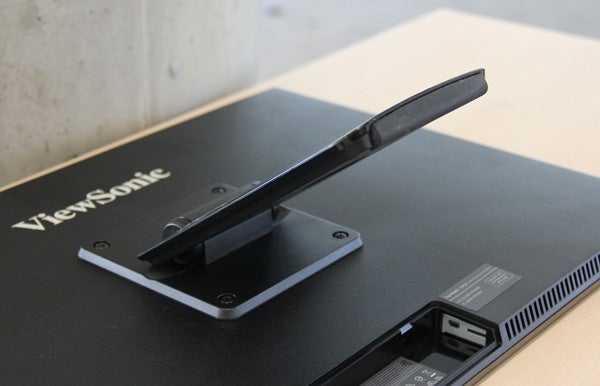
This lets it fit into places other than the office easily, but the ViewSonic VSD220 Smart Display build and looks aren’t quite on-par with some of its more expensive all-in-one PC alternatives.
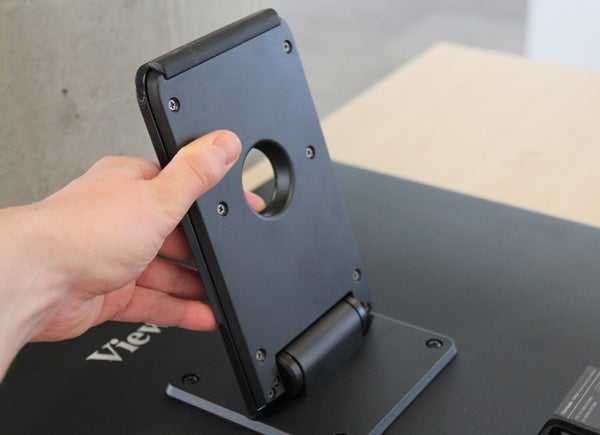
Its frame is all-plastic, even the brushed metal-effect strip at the bottom that wants to will you into believing it’s a little classier, and it’s not exactly stunningly pretty. It’s no Sony Vaio Tap 20, but it costs a fraction of the price.
Verdict
The Viewsonic VSD220 Smart Display has an awful lot going for it. £330 might be a lot for a 22-inch PC monitor. But when you factor in the Android functionality along with support for Windows 8 touch, it’s a compelling package.
At least it is on paper. In practice, performance in Android mode is often painfully slow. It’s just not a remotely pleasant device to use for web browsing or frankly much else. It’s not an ideal touchscreen for use with Windows 8, either.
We really want to like the Viewsonic VSD220 Smart Display. It’s a great concept that promises a lot and just occasionally delivers.
But it needs a faster processor and an upgrade to Android Jelly Bean at the bear minimum before we can fully recommend it. The wait, therefore, continues for the ideal touch-enabled desktop device.
Should I buy the ViewSonic VSD220?
With a USB mouse and keyboard connected, you can work in Android as you would in Windows, switching to your PC only when you need your desktop’s performance.
Sadly though, it runs Android using a very weak processor that makes many tasks noticeably sluggish. Gmail and Angry Birds run fine but if you’re keen to edit photos or play more demanding games then you’ll be disappointed with the performance.
Unfortunately it doesn’t perform much better as a monitor either. The Full HD resolution is let down by rather cold, lacklustre colours and there’s only one input for your PC — micro-HDMI.
Although the combination of tablet and a monitor is an interesting and attractive concept, the D220 doesn’t impress as either. For the same money you could buy a 22-inch regular ViewSonic monitor and a Google Nexus 7 tablet for Android apps and still have change from £300.
Using the VSD220 as an Android tablet
With a touchscreen, internal processor and Android software, the D220 can effectively be used a massive tablet. It’s far too big to carry around of course, and there’s no battery inside so it behaves more like an Android-based all-in-one desktop. If you have the right set of apps then there’s no reason why you can’t use it in much the same way you would a regular PC.
The standard Android 4.0 Ice Cream Sandwich interface is present, bringing you multiple homescreens to fill up with apps and live widgets. Any apps you don’t want cluttering up the front page hide away in a grid. It’s exactly the same Android you know and possibly love on your existing phone or tablet. Only bigger.
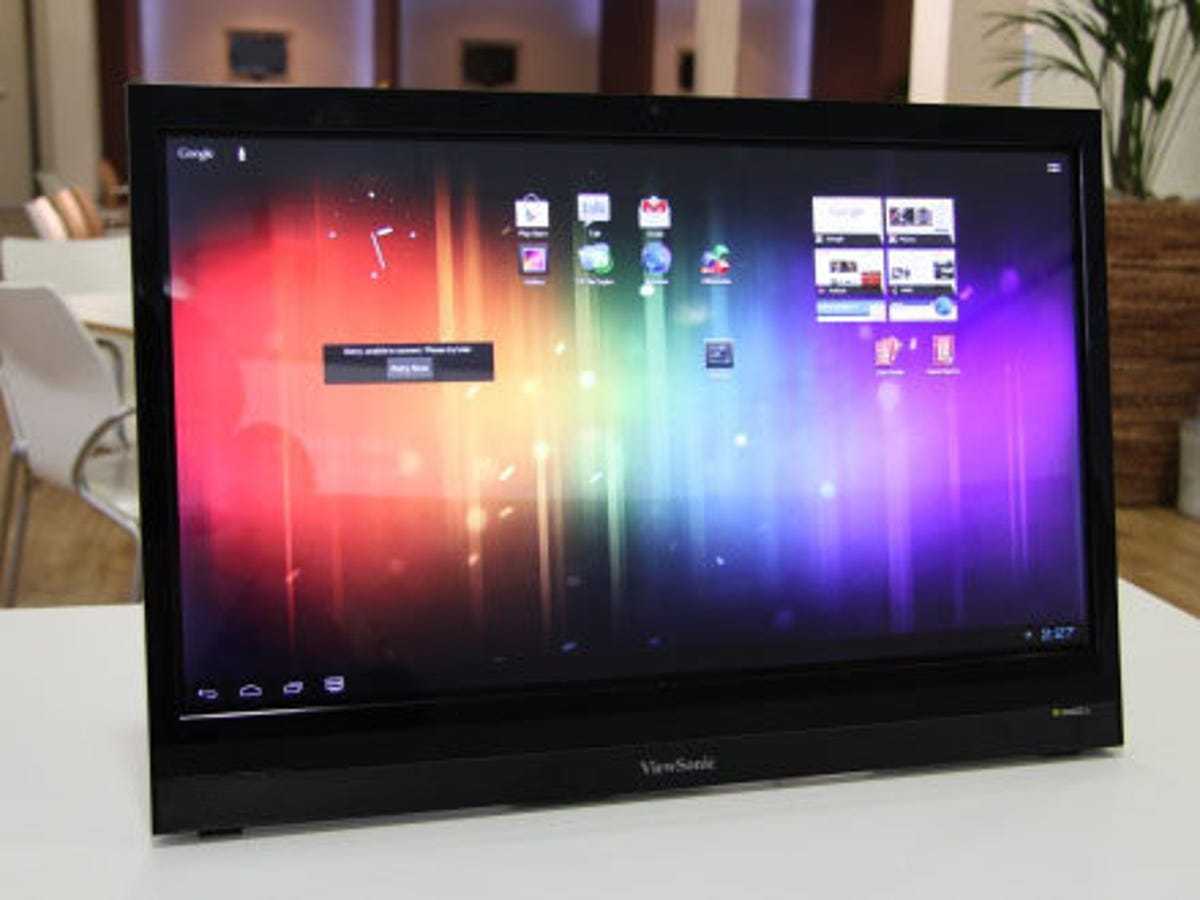
Fill up those Android homescreens with any number of apps and widgets.
Having Android on board gives you full access to the thousands of apps on the Google Play Store, although some of them are arguably a little pointless with such a big screen. Games like Riptide GP are more fun when you can tilt the device to turn your little racer on screen. With no accelerometer, you can’t do the same with the D220 — even if you could pick it up for long enough.
Alternatively, download the Google Drive app and get to work in Google’s Docs suite. When you first sign in, it will automatically sync your Gmail accounts anyway, so there’s very little setup required.
Sadly though, not all is perfect. It’s powered by dual-core 1GHz processor, which is weedy even by low-end smart phone standards. On a phone it would be fine as the small resolution is less demanding and you won’t care about watching high definition video and playing big-screen games. On the D220 however that’s probably not going to be the case.
Navigating around the interface is very sluggish, with a noticeable delay when swiping between homescreens and opening menus. Loading a high-resolution photo required a several second wait for it to properly render and high definition videos sometimes seemed a little jumpy.
Android
What to make of the Viewsonic VSD220 as an Android device? Unfortunately, it’s hard to avoid drawing the conclusion that it’s a little clunky.
Much of that is down to the combination of the mediocre TI OMAP4 dual-core processor and the large 1,920 x 1,080 pixel grid. It makes for frequently sluggish performance and occasionally painful slowdowns.
That applies to everything from demanding web content and third party apps to some of the native Google apps. Even Google Maps feels fairly reluctant.
But even with a more powerful processor, things wouldn’t be perfect. For starters, Android Ice Cream Sandwich may not be ancient, but it does feel dated and unfinished.
It also makes for an unsatisfactory browsing experience. Web pages that are capable of detecting mobile operating systems based on browser technology immediately assume you’re viewing on a smartphone or tablet and serve up a dumbed down experience.
Admittedly most allow you to switch to the full desktop version. But even here, pages are scaled up as they would be on a tablet. In other words, despite 22-inch diagonal and generous resolution, web pages feel cramped and the scaled-up images are blurry.
There’s no support for flash video, either, which doesn’t exactly boost the browsing experience. The app experience is patchy, too.
The iPlayer app, for instance, simply doesn’t work, stalling at the point of video load. Some apps can behave oddly when it comes to screen orientation, with some elements only running in portrait mode, which isn’t much use.
It’s a shame, because the screen itself is reasonably responsive and accurate. Overall, there’s just enough that works well enough to give a glimpse of what could be a nice little desktop machine for light use, perhaps on a kitchen counter top.
The fact that it’s Android also means you can slap on your favourite apps – or at least the ones that don’t depend on GPS functionality.
Check out our video walkthrough…
The most interesting part of the Viewsonic VSD220 package is the Android fucntionality. The enabling hardware starts with optical touch technology with support for multi-touch.
Then there’s a a TI OMAP4 processor. It’s not exactly the fastest chip in Christendom. Many smartphones have more powerful CPUs. By it chugs along at a respectable 1GHz and sports two cores.
As for memory, we’re talking 1GB of RAM and a further 8GB of flash memory for mass storage. Storage expansion is amply catered for courtesy of three USB ports and a MicroSD slot.
As for networking and connectivity, b/g/n Wi-Fi is built in, as is a physical ethernet adapter and Bluetooth 2.1. There’s a camera, too, for video call duties.
In short, it’s a full function Android machine. Compared with a typoical smartphone only lacks GPS, which would obviously be redundant for a desktop dwelling device.
On the software side, Viewsonic has gone with Android 4.0.4, a version of Ice Cream Sandwich. So a fairly recent build, but not the latest Jelly Bean variant.
ViewSonic VSD220 Smart Display Connectivity
The ViewSonic VSD220 Smart Display’s on-body connectivity opens-up its usefulness much further. There’s a microSD slot to let you jam in a memory card, two USB ports on the right edge for plugging-in a mouse or keyboard, a 3.5mm headphone jack and an Ethernet port.
All these help the ViewSonic VSD220 excel as a giant Android tablet, but there’s also a microUSB port on the left edge that lets the
display work as a touchscreen interface for another device, and a
microHDMI video input on the rear. You can plug in a Windows 8 PC if you
like, or even a games console.
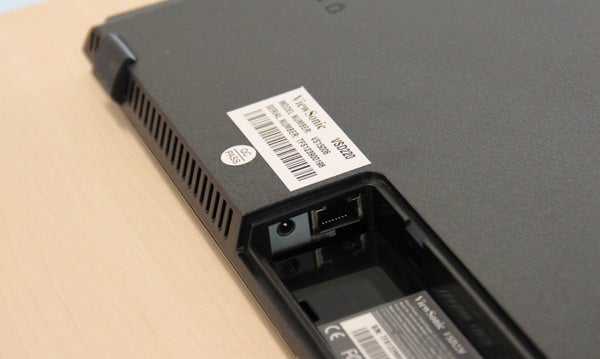
ViewSonic makes it easy to switch between roles as an Android computer and a “slave” monitor easily, with an OSD (on-screen display) shortcut plugged into the persistent Android nav bar.
Using the VSD220 as a monitor
When Android just doesn’t cut the mustard you can switch the D220’s input over to your regular PC. Thankfully it’s a very easy task. When in Android mode, you’ll spy a little button marked ‘OSD’ next to the usual navigational buttons on the bottom bar. Pressing it opens a window letting you switch to PC use or control volume and brightness levels.
Pressing and holding the power button in Windows mode brings up the same dialogue box for you to switch back to Android at any time.
It might be an easy process to switch between the two, but the D220 isn’t the best monitor in the business. There’s only one input — micro-HDMI — eschewing the usual full size HDMI, VGA and DVI ports you’d find on most monitors. A micro-HDMI to HDMI cable comes in the box, but if you want to plug it into a VGA out on your PC, you’re going to struggle.
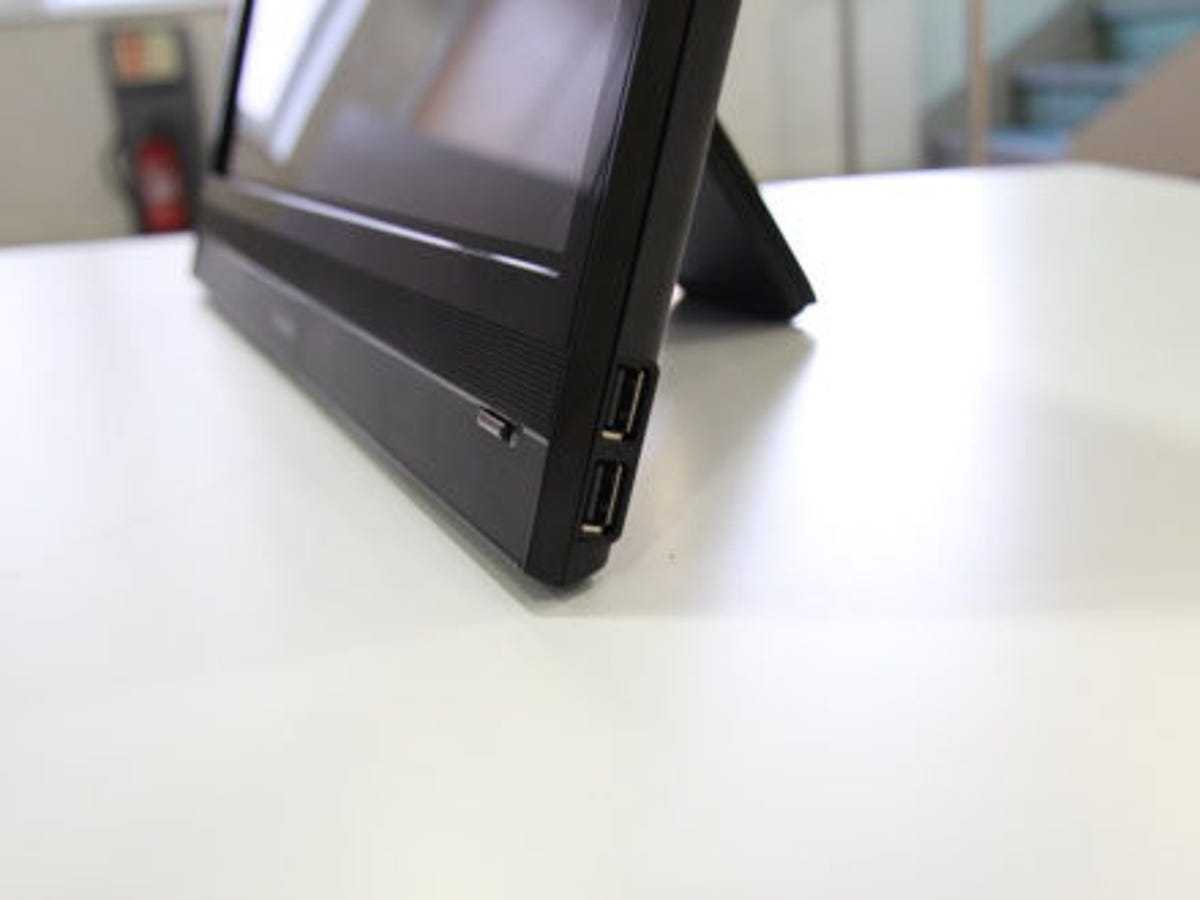
It’s fair to say that the D220 is severely lacking in useful ports.
It also can’t be used with touch input when hooked up to your PC. As it’s only connected via HDMI, there’s no way for the screen to communicate the touches back to your computer. That’s not a problem for Windows 7 but if you’re after a touchscreen monitor to swipe around the colourful Windows 8 interface then this isn’t the chap for you.
ViewSonic VSD220 Smart Display Screen
At 21.5 inches across, the ViewSonic VSD220 Smart Display is the size of a standard computer monitor. Aside from the multi-touch optical touchscreen tech that’s built into the bezel, its display looks a good deal like that of the computer monitor too.
It uses a 1080p panel of the TN type, still the most common sort found in low-cost screens. The benefit of TN screens is that their response times are quick, eliminating motion blur issues. They’re not so hot on most other fronts, though.
The ViewSonic VSD220 Smart Display’s picture quality is unremarkable. Colours aren’t particularly lively, areas of black have a slight blue-ish tint to them and if you view the screen from underneath, contrast shift robs the image of any presence. Of course, this is not a screen that you’re meant to look at from below, and horizontal angled viewing only causes some loss of brightness.
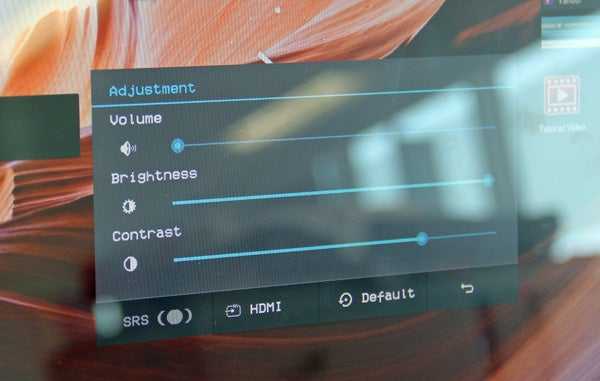
This sort of performance is standard for a screen of this type, but it’s not the only kind of touchscreen you can get at the price. The Dell ST2220T uses an IPS panel and similar optical touch technology, but doesn’t have any Android goodies – it’s a dumb monitor.
Here’s the issue – there’s not much out there like the ViewSonic VSD220 Smart Display. This makes it on one hand an interesting device, but it also makes quantifying its worth tricky. If you just want a touchscreen monitor to use with a Windows 8 computer, you can get non-smart alternatives for around £100 less. And if Android is the main draw, it feels better within a tablet.
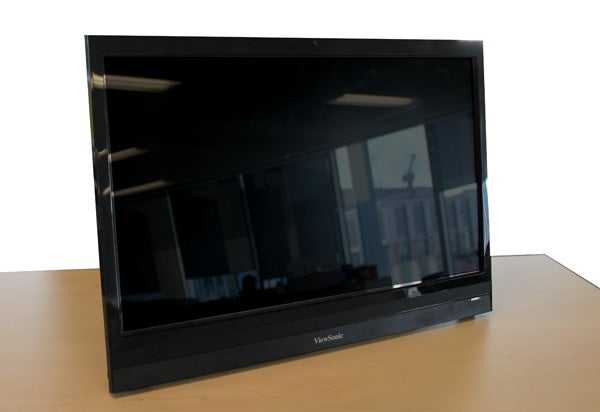
Do you want both a touchscreen monitor and an Android box for the house? The ViewSonic VSD220 Smart Display is a surprisingly good entry, given the quality of some of ViewSonic’s past Android tablet efforts, and even if you don’t like the feel of using such a large touchscreen, mouse input is only a minute away.
Performance
For the most part, the Viewsonic VSD220 is a conventional 22-inch TN panel in the modern idiom. That means colours are rich and saturated and the overall image quality is good.
It performs well enough in our test images, with little evidence of compression in either black or white scales.
Admittedly, IPS technology makes for better colour accuracy and viewing angles. And PVA panels have significantly deeper blacks. And by TN standards the pixel response is pretty ordinary.
But this is a pretty decent panel overall. HD video content looks lovely and games look great, too. The recessed bezel housing the optical touch kit doesn’t detract from the experience, either. Just bear in mind that with the touch capability comes a glossy, somewhat reflective surface and, inevitably, dirty finger marks.
On the subject of touch in the context of the Viewsonic VSD220’s PC monitor capabilities, it’s worth noting that it’s compatible with Windows 8. However, the usual reservations apply when it comes to optical touch screens and Windows 8.
Using gestures that involving swiping in from off the edge of the display are problematical due to the raised bezel.
Дизайн
ViewSonic VSD220 крайне напоминает обычный моноблочный ПК. Подставка отсутствует, в качестве опоры выступает нижняя грань монитора, с задней стороны устройство поддерживается ножкой из пластика. Можно отрегулировать угол наклона от 15 до 70 °, благодаря чему устройство легко превращается из обычного монитора в большой планшет и обратно. Однако не предусмотрена регулировка высоты, в связи с чем расположение экрана некоторым пользователям может показаться неудобным, похожим больше на дисплей ноутбука нежели на обычный настольный монитор.
Глянцевую переднюю панель сверху дополняет 1.2-мегапиксельная веб-камера, а снизу — кнопка включения и встроенные динамики. Стоит отметить, что кнопка включения в ViewSonic VSD220 работает по аналогии с кнопкой у планшета на Android. В отличие от стандартной кнопки включения мониторов, при выборе режима «Android» эта кнопка ViewSonic VSD220 активирует спящий режим при коротком нажатии на нее, а при долгом — меню выключения монитора. В режиме «монитор» при долгом нажатии на кнопку включения вызывается меню системы с опцией переключения устройства в Android-окружение.
Для подключения периферийных устройств на правой панели ViewSonic VSD220 сбоку размещаются 2 USB-порта, для подключения к ПК в режиме монитора с сенсорным вводом — порт micro-USB на левой панели, где также располагается выход на наушники. Повернув монитор задней стороной, мы увидим, что производитель позаботился и о возможности крепления на стену (при условии отсоединенной ножки). В нижней части устройства, прикрытые малоприметной крышкой, располагаются порт Ethernet, micro-HDMI вход, разъем питания и слот для карт micro-SD. Из-за отсутствия встроенного аккумулятора, монитор работает исключительно от электрической сети — для этого в крышке отсека устройства располагается специальное отверстие, сквозь которое будет проходить кабель питания или HDMI.
Design and build quality
In terms of design, the D220 looks basically like any other monitor on the market. To accommodate its 22-inch screen it has to measure 513mm wide, so it won’t sit too comfortably on tiny desks.
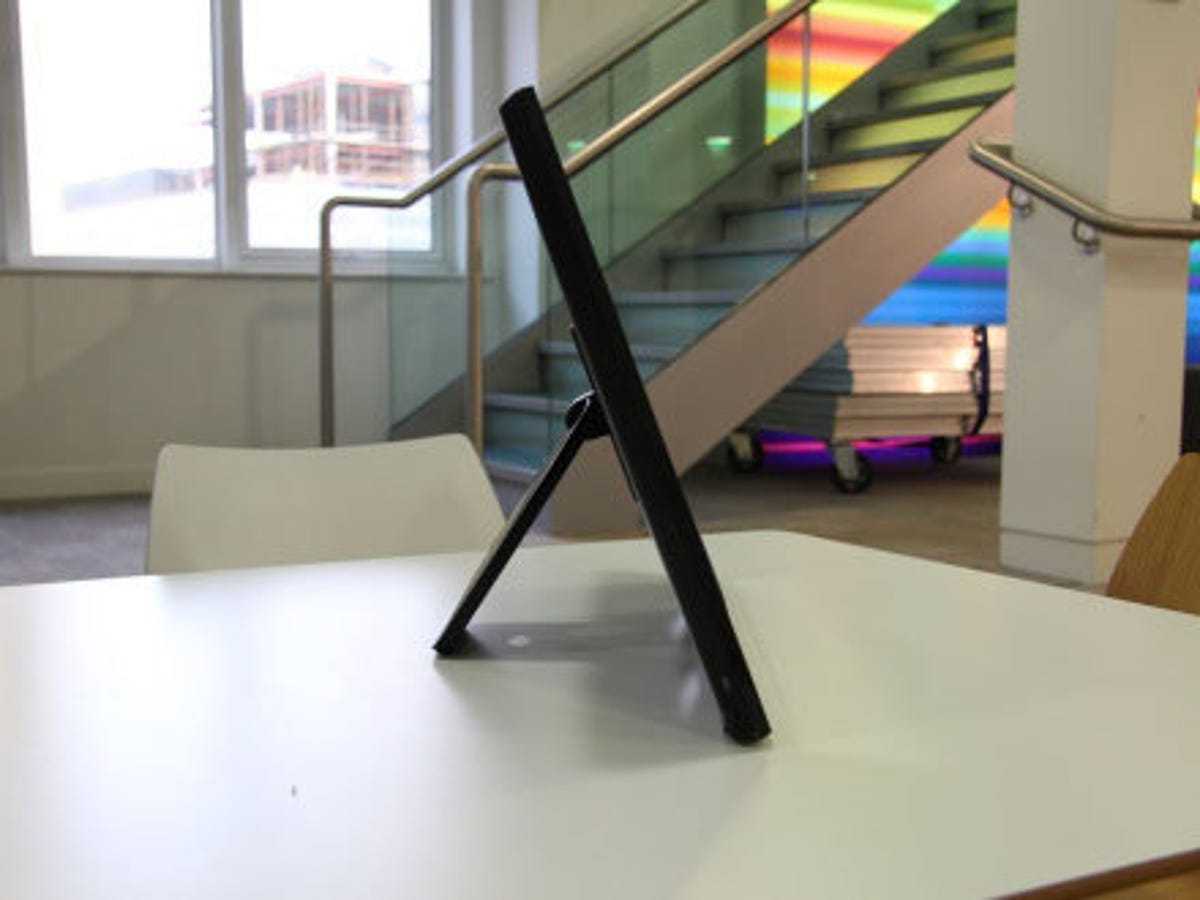
The kickstand gives the VSD220 a sleeker look than most monitors.
It sits directly on the desk propped up by a kickstand, rather than having a proper stand with a base as you’d expect to see on most monitors. This does makes it look quite sleek, and I’d be much happier having this in my living room than a standard PC display. It does mean that you can’t alter its height though, so if you’re working on a desk and want to raise it up, you’d better have a couple of Yellow Pages to hand.
The display is bordered by a slim, black plastic bezel, with thicker, grey plastic along the bottom. It’s an inoffensive design although it feels a bit plasticky in places. You’re not likely to be carrying it far away from your table though, so it shouldn’t fall apart on you.
The kickstand is sturdy and allows the whole thing to lie almost flat, letting you swipe around the Android interface as if it were a regular tablet.
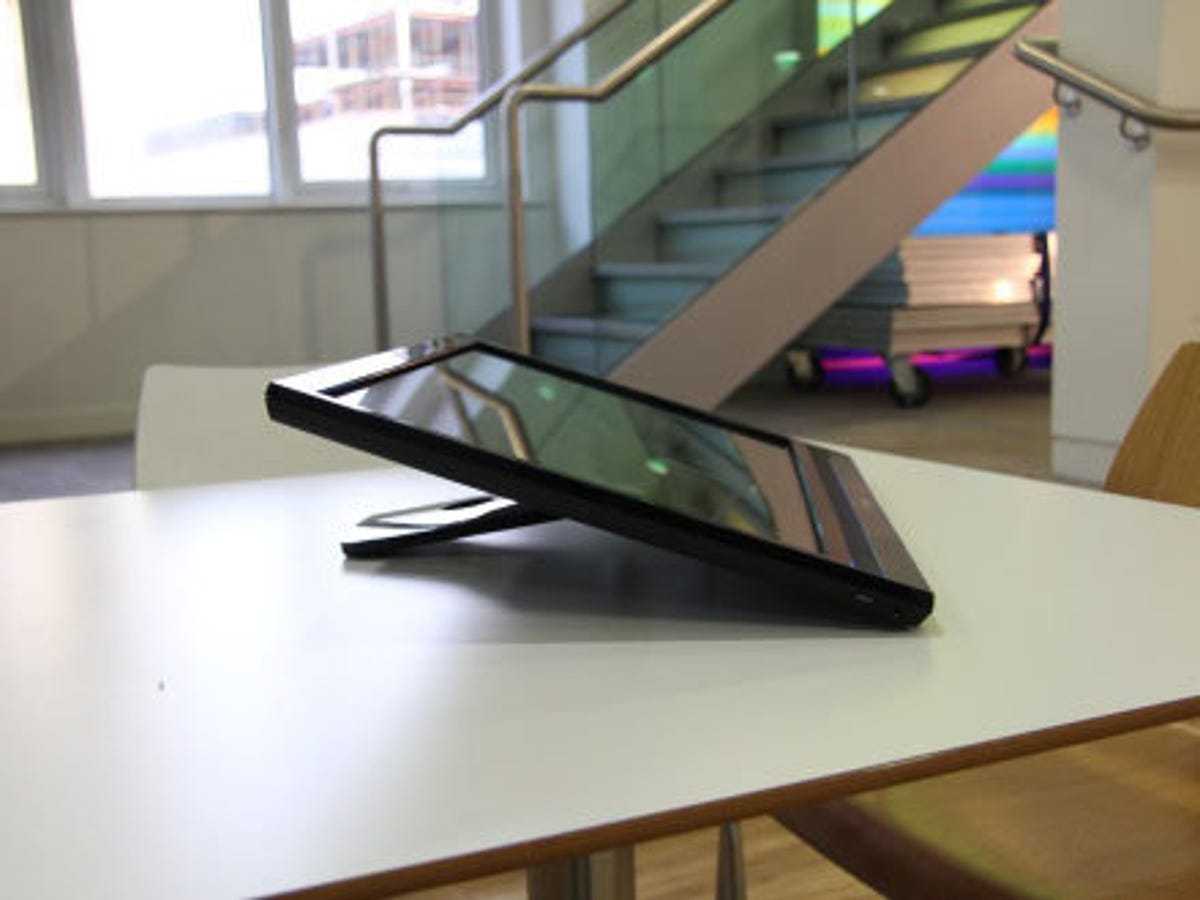
You can lie the monitor almost flat and swipe around it like a tablet.
Around the edges you’ll find a micro-USB port, two full size USB 2.0 ports and a 3.5mm headphone jack. On the back is a microSD card slot, a micro-HDMI port and an Ethernet port. There’s a webcam on the front too, letting you video call your favourite people over Skype.
Экран
Экран ViewSonic VSD220 — это TN-панель размером 22 дюйма с подсветкой White-LED, разрешением 1920х1080 и соотношением сторон 16:9. Время отклика монитора — 5 мс.
Из-за отсутствия настроек и регулировок, как и нескольких предустановленных режимов, пользователю монитора оказываются доступны исключительно заводские настройки (не считая контрастности и яркости, которые можно регулировать в режиме Android). В «родных» настройках мы отметили весьма стабильный график температуры цвета, совсем немного превышающий стандартное значение, равное 6500K. Однако кривая гаммы у ViewSonic VSD220 заметно занижена — что особенно бросается в глаза в темных областях и приводит в целом к блеклости картинки. Если начать регулировать контрастность, в светлых областях кривая начнет сначала плавно подниматься и, достигнув максимума в районе 80%, резко падает. Для оптимального качества изображения данный параметр необходимо будет установить на отметке 70-80% — тогда при некоторой блеклости картинки не будет наблюдаться заметных потерь деталей или искажений в полутонах.
При измерении максимальной яркости у ViewSonic VSD220, проводимой по 35-ти точкам, выявился средний показатель, равный 220 кд/м2. При этом разница между самым высоким и самым низким показателями составила порядка 40 кд/м2 — неплохой результат. Высокой яркостью отличается центральная зона экрана ViewSonic VSD220, минимальной — угловые области.
Подводим итоги
Проанализировав основные характеристики ViewSonic VSD220, мы пришли к выводу, что новинка эта довольно специфичная. С ролью моноблока ViewSonic VSD220 не справляется, так как Android все же не отвечает множеству требований, предъявляемым к подобным устройствам. В качестве настольного монитора использовать VSD220 можно, но возникает несколько недоразумений. Во-первых, будучи подключенным к ПК с ОС Windows 8, этот сенсорный монитор немногим сможет расширить функциональность компьютера и повысить качество вашей работы своим Android. Во-вторых, цена монитора, заметно превышающая цены на 22-дюймовые TN-мониторы, для многих пользователей станет неоправданной.
Что касается плюсов нового устройства, то стоит отметить его способность выступать для презентаций, однако эта характеристика вряд ли заинтересует домашнего пользователя устройства.
Преимущества:
- Экран большого размера с сенсорным управлением
- ОС Android ICS
Недостатки:
- Недостаточная производительность в Android
- Сенсор работает только по 2-м касаниям
- Высокая цена
